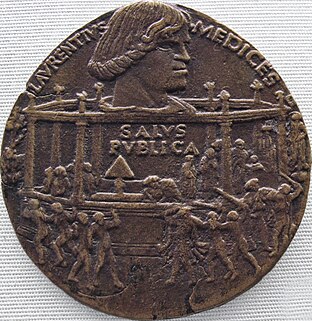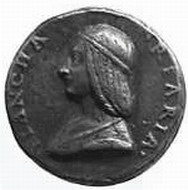Related Research Articles

Lorenzo di Piero de' Medici was an Italian statesman, banker, de facto ruler of the Florentine Republic and the most powerful and enthusiastic patron of Renaissance culture in Italy. Also known as Lorenzo the Magnificent by contemporary Florentines, he was a magnate, diplomat, politician and patron of scholars, artists, and poets. As a patron, he is best known for his sponsorship of artists such as Botticelli and Michelangelo. He held the balance of power within the Italic League, an alliance of states that stabilized political conditions on the Italian peninsula for decades, and his life coincided with the mature phase of the Italian Renaissance and the Golden Age of Florence. On the foreign policy front, Lorenzo manifested a clear plan to stem the territorial ambitions of Pope Sixtus IV, in the name of the balance of the Italian League of 1454. For these reasons, Lorenzo was the subject of the Pazzi conspiracy (1478), in which his brother Giuliano was assassinated. The Peace of Lodi of 1454 that he supported among the various Italian states collapsed with his death. He is buried in the Medici Chapel in Florence.

The House of Medici was an Italian banking family and political dynasty that first began to gather prominence under Cosimo de' Medici, in the Republic of Florence during the first half of the 15th century. The family originated in the Mugello region of Tuscany, and prospered gradually until it was able to fund the Medici Bank. This bank was the largest in Europe during the 15th century, and it facilitated the Medicis' rise to political power in Florence, although they officially remained citizens rather than monarchs until the 16th century.

Cosimo di Giovanni de' Medici was an Italian banker and politician who established the Medici family as effective rulers of Florence during much of the Italian Renaissance. His power derived from his wealth as a banker, and he was a patron of arts, learning and architecture. He spent over 600,000 gold florins on art and culture, including Donatello's David, the first freestanding nude male sculpture since antiquity. Despite his influence, his power was not absolute; Florence's legislative councils at times resisted his proposals throughout his life, and he was viewed as first among equals, rather than an autocrat.

Cosimo I de' Medici was the second Duke of Florence from 1537 until 1569, when he became the first Grand Duke of Tuscany, a title he held until his death.

The Republic of Florence, officially the Florentine Republic, was a medieval and early modern state that was centered on the Italian city of Florence in Tuscany. The republic originated in 1115, when the Florentine people rebelled against the Margraviate of Tuscany upon the death of Matilda of Tuscany, who controlled vast territories that included Florence. The Florentines formed a commune in her successors' place. The republic was ruled by a council known as the Signoria of Florence. The signoria was chosen by the gonfaloniere, who was elected every two months by Florentine guild members.

Piero di Cosimo de' Medici , was the de facto ruler of Florence from 1464 to 1469, during the Italian Renaissance.

The Pazzi conspiracy was a plot by members of the Pazzi family and others to displace the Medici family as rulers of Renaissance Florence.

Caterina Sforza was an Italian noblewoman, the Countess of Forlì and Lady of Imola, firstly with her husband Girolamo Riario, and after his death as a regent of her son Ottaviano.

Girolamo Riario was Lord of Imola and Forlì. He served as Captain General of the Church under his uncle Pope Sixtus IV. He took part in the 1478 Pazzi Conspiracy against the Medici, and was assassinated 10 years later by members of the Forlivese Orsi family.

Giovanni di Cosimo de' Medici was an Italian banker and patron of arts.

San Marco is a religious complex in Florence, Italy. It comprises a church and a convent. The convent, which is now the Museo Nazionale di San Marco, has three claims to fame. During the 15th century it was home to two famous Dominicans, the painter Fra Angelico and the preacher Girolamo Savonarola. Also housed at the convent is a famous collection of manuscripts in a library built by Michelozzo. Furthermore, the church houses the tomb of Pico Della Mirandola, Renaissance philosopher and so called father of humanism.
Lorenzo the Elder was an Italian banker of the House of Medici of Florence, the younger brother of Cosimo de' Medici the Elder and progenitor of the so-called "Popolani" line of the family, named for a later generation whose members were supporters of the Florentine political activist Girolamo Savonarola.

Clarice Orsini (1453–1488) was the daughter of Iacopo Orsini, and his wife and cousin Maddalena Orsini both from the Orsini family, a great Roman noble house and was the wife of Lorenzo de' Medici.

Contessina de' Bardi, was an Italian noblewoman from the House of Bardi. Her marriage into the House of Medici provided her husband's family with much needed nobility, prestige, and military support as they established their power in Florence.

Bianca Riario was an Italian noblewoman and regent, Marchioness of San Secondo by marriage to Troilo I de' Rossi, and regent of the marquisate and county of San Secondo for her son Pier Maria during his minority between 1521 and 1522. She was the eldest child and only daughter of Caterina Sforza by the latter's first husband, Girolamo Riario, a nephew of Pope Sixtus IV.

Medici is a historical drama created by Frank Spotnitz and Nicholas Meyer. The series was produced by Italian companies Lux Vide and Rai Fiction, in collaboration with Frank Spotnitz's Big Light Productions.
"The Hanged Man" is the pilot episode of the American TV series Da Vinci's Demons. It is directed by David S. Goyer and starring Tom Riley, Laura Haddock, Elliot Cowan, Blake Ritson and Lara Pulver. It is produced by Starz! Network and BBC Worldwide. The story is focused on Leonardo da Vinci and his two companions Zoroaster and Nico, who took Florence and established alliance with Lorenzo de' Medici.
"Original Sin" is the pilot episode of the Italian-British TV series Medici: Masters of Florence. It was written by Nicholas Meyer from a story by Frank Spotnitz and Nicholas Meyer and directed by Sergio Mimica-Gezzan. It was released on 9 December 2016. It got 8.04 million viewers and 28.90% of share.
"The Dome and the Domicile" is the second episode of the TV series Medici: Masters of Florence, directed by Sergio Mimica-Gezzan and starring Dustin Hoffman and Richard Madden. It was released on 18 October 2016. It got 7.14 million viewers in Italy.
References
- ↑ "Medici: Masters Of Florence Season 1 Episode 3 — Pestilence". Sbs.com.au . SBS on Demand . Retrieved 5 February 2019.
- ↑ "Medici: Masters of Florence". Netflix.com . Archived from the original on 29 July 2018. Retrieved 5 February 2019.
- ↑ Buonocore, Mattia (26 October 2016). "MARTEDI 25 OTTOBRE 2016. I MEDICI SI ASSESTANO SUL 25.7% (6,5 MLN), CANALE 5 AL 9.9%. LA7 (4.2%) BATTE RETE 4 (4%), MEDIASET EXTRA OTTAVO CANALE (1.8%) FA QUASI IL DOPPIO DI TV8 (0.9%) E DI NOVE (1%)". Ascolti TV (in Italian). NanoPress. Retrieved 2 November 2018.